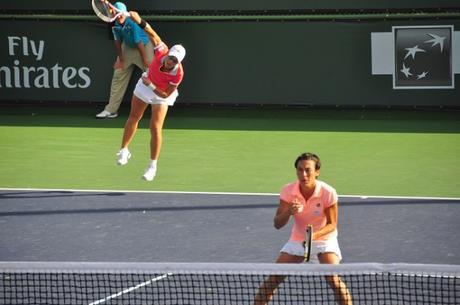
Have you ever played a doubles tennis match in which either you or your partner are consistently losing your service games, even if you're both serving well? When that happens, do you tend to play it safe and/or pray to the tennis gods that you will eventually win your serve?
And... how is that working for you?
Believe me, I know that frustration, because honestly speaking, if you can't hold your serve, you can't win the match.
It's important to remember that if something isn't working, you should try something different. Give one (or all) of these strategies a try, and you'll find yourself winning your serve - and your matches!
Poach
One strategy is poaching, or volleying the opponent's return. To do this, you want to try and place your serve down the middle, or "T" of the service box. When receiving a serve down the "T", the returner doesn't have much of an angle to go for a passing shot down the line, and will more than likely return up the middle, so your partner at the net should be ready to take a step or two toward the middle of the court and move in diagonally to volley the return. A great target is right at the feet of the returner's partner, which will either result in a winner or an awkward pop up which can then be put away.
I-formation
Mess with your opponent's mental game by changing up the look of the court with the I-formation. This works especially well when you have a fearless partner at the net.
When serving, stand closer to the center mark, as if serving for a singles game, and have your partner straddle the center line in the service boxes and get down low - you definitely DON'T want to hit your partner with the ball :) This new look on the court will force the returner to worry more about which direction the player at net will move than their return, usually resulting in a less impactful shot.
When using this formation, you want to aim your serve more down the middle or to the body. This will take away the angles for the return and make it easier for your partner to poach at the net. Communication is key, and both you and your partner need to discuss which side of the court the one at the net will go. Very few club players use hand signals like the pros (myself and my partner included), so I suggest a quick exchange at the baseline right before the serve.
** NOTE: Be careful if using this against an opponent who either has a great backhand and/or loves to rip the returns down the line. They might be able to run around your serve and smack a winner before you can move over to cover it.
Australian
If the return team has consistent, strong cross court returns, the Australian formation is another great strategy to use - especially when serving from the ad side and to a returner's weak backhand. This is similar to the I-formation, only the player at the net stands in the service box on the same side as the server. But it's different in that the server will go out wide, forcing the returner to hit their backhand down the line, or risk their return being picked off at the net.
** NOTE: Use this with a hard and flat serve out wide, and on your first serve only. With the court being open, you're at risk of them running around a weaker second serve and ripping it down the line before you can get there to cover it.
Both back on the baseline
The last strategy a serving team should try is for the server and the server's partner to both play back at the baseline. Now, I know what you're thinking... "The goal in doubles is to control the net, so WHY would we both stand back at the baseline.. on purpose?!" Well, if you're having trouble holding serve against a team who consistently rips the ball right at the net player, then this is a good strategy to try as it
- takes away their "sitting duck", and
- allows you to throw up offensive, deep lobs over their net player, which will force your opponent to move back and hit defensively, giving you and your partner an opportunity to move in to the net and take care of business.
**NOTE: Definitely give this a try on your second serve, and if you have a weak first serve.
So the next time you find that either you or your partner are having trouble holding serve, go ahead and test out these strategies. Changing up the look of the court, playing more aggressively, and keeping your opponents on the defense ALL will help change the momentum so your team can win more matches!



